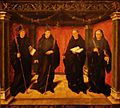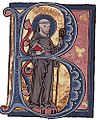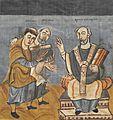Benedictine facts for kids
The word Benedictine usually refers to a follower of the Order of Saint Benedict. These people usually lead a life in a special religious home called an abbey. They follow a set of rules created by Benedict of Nursia. Benedict lived a long time ago, in the 6th century. He wrote down rules, known as the Rule of St Benedict, that these people still follow today. The main ideas of these rules are pax (which means peace) and ora et labora (which means pray and work).
Most Benedictines are part of the Catholic Church. However, you can also find some in the Eastern Orthodox Church and the Anglican Church. The official name for their group is Ordo Sancti Benedicti, often shortened to OSB.
Contents
The Benedictine Order: A Way of Life
The Order of Saint Benedict is a very old group of monks and nuns. They dedicate their lives to God by living together in communities. Their way of life is based on the teachings of Saint Benedict of Nursia.
Who Was Saint Benedict of Nursia?
Benedict of Nursia was born in Italy around the year 480. He decided to live a life focused on prayer and quiet reflection. He became famous for his wisdom and his ability to guide others. Many people came to him for advice. He founded several monasteries, including the famous Monte Cassino.
The Rule of Saint Benedict
Saint Benedict wrote a guide for monks and nuns called the Rule of St Benedict. This rule helps them live together in peace and serve God. It covers everything from how to pray to how to work and how to treat each other.
- Ora et Labora: Pray and Work
This famous phrase sums up the Benedictine way of life. It means that prayer and work are both very important. Monks and nuns spend time praying, reading religious texts, and doing manual labor. This could be farming, cooking, or even scholarly work.
- Pax: Peace
Peace is a core value for Benedictines. They try to live peacefully within their communities and with the outside world. Their monasteries are often seen as places of calm and quiet.
Life in a Benedictine Abbey
Life in an abbey is very structured. Monks and nuns wake up early for prayer services throughout the day. They also spend time working, studying, and helping their community. Each abbey is independent, meaning it makes its own decisions, but they all follow the Rule of Saint Benedict.
Benedictine monasteries have played a huge role in history. They helped preserve knowledge and learning during difficult times. They copied books, taught people, and developed new farming methods. Many famous scholars and leaders came from Benedictine abbeys.
Images for kids
-
Benedict of Aniane (747–821).
-
Benedictine monks singing Vespers on Holy Saturday in Morristown, New Jersey, U.S.
-
Saint Boniface (c. 680 – 750), Pope Gregory I (c. 540 – 604, pope 590–604), Adalbert of Egmond (8th century) and priest Jeroen van Noordwijk, depicted in a 1529 painting by Jan Joostsz van Hillegom currently on display at the Frans Hals Museum
-
Late Gothic sculpture of Rupert of Salzburg (c. 660 – 710)
-
Bernard of Clairvaux (1090–1153) featured in a 13th-century illuminated manuscript
-
A Carolingian manuscript, c. 840, depicting Rabanus Maurus (left), supported by Alcuin (middle), presenting his work to Otgar of Mainz
-
Self portrait of Matthew Paris (c. 1200 – 59)
-
Abbot Suger (c. 1081 – 1135) in a medieval stained-glass window
-
Abbot of Montserrat
See also
 In Spanish: Orden de San Benito para niños
In Spanish: Orden de San Benito para niños















